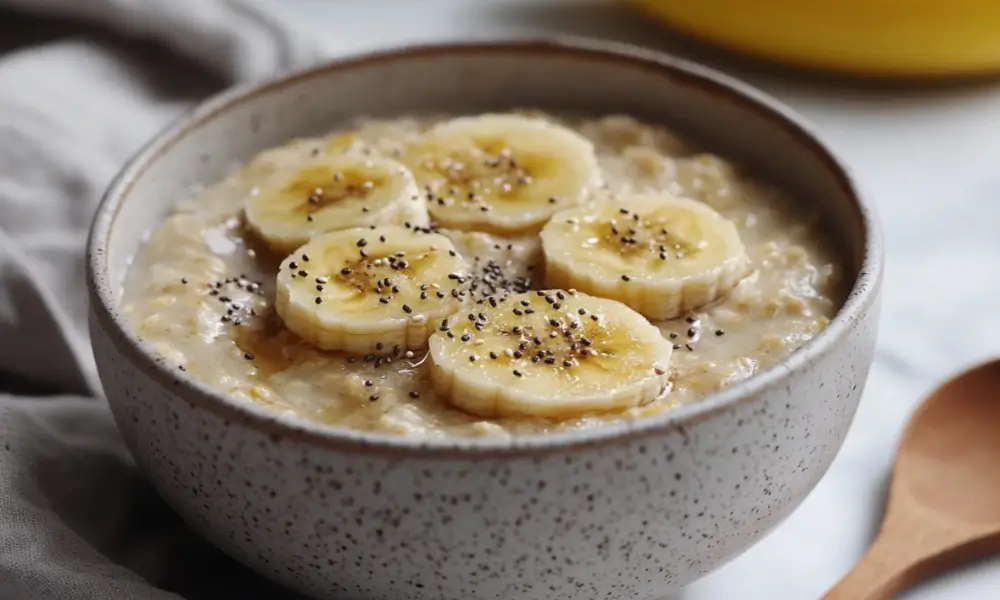Have you ever wondered if oatmeal is okay for a low FODMAP diet? 🤔 If so, you’re not alone! This question pops up all the time for people looking to manage digestive issues while still enjoying their favorite breakfast foods. The good news is that oatmeal can absolutely fit into a low FODMAP diet, but only if you know what to look for. Let’s dive into everything you need to know about oatmeal and the low FODMAP diet!
What Is a Low FODMAP Diet?
First things first: what is a low FODMAP diet, and why does it matter? A low FODMAP diet is a medically recommended eating plan designed to help people with digestive issues, like irritable bowel syndrome (IBS). It focuses on reducing certain types of fermentable carbs, also known as FODMAPs (Fermentable Oligosaccharides, Disaccharides, Monosaccharides, and Polyols). These sneaky carbs can cause bloating, gas, and other unpleasant symptoms.
Understanding FODMAPs and Their Impact on Digestion
Imagine FODMAPs as mischievous troublemakers in your digestive system. They slip in unnoticed, start fermenting in your gut, and stir up all sorts of chaos! Many foods rich in FODMAPs contain easily fermentable carbohydrates that the small intestine struggles to break down completely. Instead of being fully absorbed, these carbs travel to the colon, where they undergo fermentation, leading to gas production. As a result, some people may experience bloating, discomfort, or even digestive distress like diarrhea.
By cutting down on these high-FODMAP foods, you essentially reduce the chaos and give your digestive system a much-needed break. But be warned—it’s not just about cutting out random foods. A low FODMAP diet requires careful planning and the ability to read food labels like a detective!
Who Needs a Low FODMAP Diet?
A low FODMAP diet isn’t necessary for everyone. It’s mainly recommended for individuals diagnosed with IBS or other gut-related disorders. This approach can also be beneficial for those who frequently experience bloating, stomach pain, or unexplained digestive discomfort. If you’ve been dealing with persistent gut issues, it’s best to consult a dietitian before making significant dietary changes. They can guide you through challenging food choices, like oatmeal, while ensuring you maintain balanced nutrition.
Oatmeal and FODMAPs: The Basics

So, let’s talk oatmeal. 🥣 Is it low FODMAP? The answer is both “yes” and “no.” It depends on the type of oats, how they’re prepared, and the serving size. If you’re following a low FODMAP diet, portion control is key. But don’t worry—it’s easier than it sounds!
What Are FODMAPs Found in Oatmeal?
Oatmeal contains a type of carbohydrate called fructans. Fructans are fermentable fibers that fall into the “O” (oligosaccharides) category of FODMAPs. However, the FODMAP content in oatmeal is relatively low when eaten in the right portion sizes. That means oatmeal can be a great addition to your diet if you stick to the recommended amounts.
Here’s a little tip: when in doubt, start small. Begin with a quarter cup of oats and monitor your body’s reaction before increasing the portion. This gradual approach can save you from any unexpected digestive issues.
Is All Oatmeal Low FODMAP?
Nope, not all oatmeal is created equal. Let’s break it down:
- Rolled oats are a great low FODMAP option when consumed in portions of up to ½ cup (dry). They’re incredibly versatile, making them perfect for both sweet and savory dishes.
- Steel-cut oats: Similar to rolled oats, these are also safe for a low FODMAP diet, but their chewier texture means they take longer to cook.
- Instant oats: Proceed with caution! These often contain added sweeteners, flavorings, or milk powder, which can increase their FODMAP content. Always check the ingredient list before buying.
If you’re feeling unsure, look for oats certified as low FODMAP. Many brands now cater to this growing dietary need, making it easier than ever to shop with confidence.
The Difference Between Rolled, Steel-Cut, and Instant Oats
Choosing the right oats can feel overwhelming. Rolled oats cook quickly thanks to steaming and flattening, making them ideal for breakfasts and baking. Steel-cut oats, with their nutty texture, take longer to cook but offer a hearty bite. Instant oats are the fastest option but often contain added ingredients, leading to higher FODMAP levels. Think of it like home-cooked meals versus fast food—one takes more time but is usually the healthier choice!
The Benefits of Including Oatmeal in a Low FODMAP Diet

Why bother with oatmeal if it’s so tricky? Because it’s worth it. Oatmeal is not only versatile but also packed with nutrients that make it a great choice for breakfast or snacks. Plus, it’s one of the few breakfast staples that can be adjusted to fit almost any dietary restriction.
Nutritional Profile of Oatmeal
| Component | Amount (per ½ cup dry rolled oats) |
|---|---|
| Calories | 150 |
| Fiber | 4g |
| Protein | 5g |
| Iron | 10% DV |
Oatmeal is a powerhouse of fiber, protein, and essential minerals like iron. The fiber, in particular, is a lifesaver for people on a low FODMAP diet. It helps regulate bowel movements, supports gut health, and keeps you feeling full longer.
How Oatmeal Supports Digestive Health
Here’s where oatmeal really shines. Its soluble fiber, known as beta-glucan, acts like a sponge in your gut. It absorbs water, forms a gel-like substance, and slows down digestion. This not only helps you feel full for hours but also stabilizes your blood sugar levels.
“Oatmeal is like a hug for your gut—comforting, warm, and nourishing!”
And let’s not forget the psychological benefits of starting your day with a bowl of oatmeal. It’s like a little morning ritual that sets the tone for a balanced, low-stress day.
Common Challenges with Oatmeal on a Low FODMAP Diet
Despite its benefits, oatmeal isn’t always smooth sailing for everyone. Let’s talk about the challenges you might face and how to overcome them.
Mislabeling and Hidden Ingredients in Packaged Oats
One of the biggest pitfalls is buying pre-packaged oatmeal that seems healthy but isn’t. Those flavored instant oat packets? They often contain high FODMAP ingredients like honey or dried fruits. Always check the label for hidden surprises!
Portion Control: Why It Matters
Even low FODMAP foods can become high FODMAP if you overdo it. Stick to the recommended serving size (usually ½ cup dry oats) to keep your FODMAP intake in check. A larger serving can tip the scales and leave you feeling less than your best.
Tips for Enjoying Oatmeal on a Low FODMAP Diet
Oatmeal might sound like a tricky addition to your low FODMAP diet, but with a few smart strategies, you can enjoy this hearty breakfast without worry. Here’s how to make your oatmeal journey both delicious and gut-friendly.
Choosing the Right Oats
Not all oats are created equal, and when you’re on a low FODMAP diet, the choice matters. Stick to plain rolled oats or steel-cut oats for the best results. These types are minimally processed and don’t come with hidden surprises like sweeteners or dried fruits that could trigger digestive issues.
Look for certified low FODMAP oats if possible. Many brands now cater to this dietary need, so you’ll find options labeled specifically for people managing IBS or related conditions. Don’t forget to check the label for ingredients—simplicity is key here!
Safe Portion Sizes for Oatmeal
If oatmeal is a guest at your digestive party, think of portion control as the bouncer. Keep servings small and manageable. Generally, ½ cup of dry rolled oats is considered low FODMAP. If you’re new to this diet, start with even less—try ¼ cup and observe how your body responds.
Overeating oatmeal, even the low FODMAP kind, can tip the scales and leave you with symptoms you’re trying to avoid. Remember, moderation is your best friend here.
Best Low FODMAP Toppings for Oatmeal
What’s oatmeal without toppings, right? But when it comes to low FODMAP toppings, not all options are safe. Here’s a quick guide to flavor your oatmeal without upsetting your gut:
- Fruits: Stick to low FODMAP fruits like ripe bananas (up to 1/3 banana), blueberries (up to 20 berries), or strawberries (up to 10 medium strawberries).
- Nuts and seeds: Add crunch with chia seeds (1 tablespoon), pumpkin seeds, or walnuts (in small portions).
- Sweeteners: Go for a drizzle of maple syrup or a sprinkle of cinnamon. Avoid honey, as it’s high FODMAP.
- Non-dairy milk: Use lactose-free milk or almond milk (unsweetened and within low FODMAP serving sizes).
Get creative! Mix and match these toppings to keep your oatmeal exciting while staying safe for your gut.
Low FODMAP Oatmeal Recipes to Try
Ready to put all that knowledge into action? Here are some simple, delicious, and 100% low FODMAP oatmeal recipes that you can whip up in no time. Each recipe has been crafted with portion control and low FODMAP ingredients in mind.
Classic Low FODMAP Oatmeal with Banana Slices

This recipe is perfect for those mornings when you want something quick yet satisfying. It’s comforting, warm, and just the right amount of sweet.
| Ingredient | Quantity |
|---|---|
| Rolled oats | ½ cup (dry) |
| Water or lactose-free milk | 1 cup |
| Ripe banana | 1/3 banana, sliced |
| Cinnamon | ¼ teaspoon |
| Maple syrup | 1 teaspoon (optional) |
Instructions:
- In a small saucepan, combine the rolled oats and water (or lactose-free milk).
- Bring to a boil, then reduce the heat to simmer for about 5 minutes, stirring occasionally.
- Once the oats are creamy, remove from heat and stir in the cinnamon.
- Top with banana slices and a drizzle of maple syrup, if desired.
Enjoy this warm and cozy breakfast that’s as gentle on your stomach as it is delicious!
Savory Oatmeal Bowl with Spinach and Eggs

Who says oatmeal has to be sweet? This savory twist is packed with protein and makes a hearty start to your day.
| Ingredient | Quantity |
|---|---|
| Steel-cut oats | ½ cup (dry) |
| Water | 1½ cups |
| Spinach (fresh) | 1 cup |
| Egg | 1 (fried or poached) |
| Olive oil | 1 teaspoon |
| Salt and pepper | To taste |
Instructions:
- Cook the steel-cut oats in water according to the package instructions (usually about 20 minutes).
- In a small skillet, heat the olive oil over medium heat and sauté the spinach until wilted.
- Fry or poach the egg to your liking.
- Assemble the bowl: place the oats as a base, top with sautéed spinach and the egg. Sprinkle with salt and pepper.
This savory oatmeal is a great option for brunch or even a light dinner. It’s proof that oatmeal can be anything you want it to be!
Low FODMAP Overnight Oats with Blueberries

If mornings are always rushed, this no-cook overnight oats recipe will save the day. Prepare it the night before, and you’ll wake up to a ready-to-eat breakfast!
| Ingredient | Quantity |
|---|---|
| Rolled oats | ½ cup |
| Lactose-free milk | ¾ cup |
| Blueberries | 20 berries |
| Chia seeds | 1 tablespoon |
| Vanilla extract | ½ teaspoon |
Instructions:
- In a mason jar or container, combine the oats, lactose-free milk, chia seeds, and vanilla extract.
- Mix well, cover, and refrigerate overnight (or at least 6 hours).
- Before serving, top with fresh blueberries.
This creamy, fruity bowl of overnight oats is a lifesaver for busy mornings—and it’s low FODMAP, too!
Frequently Asked Questions About Oatmeal and FODMAPs
Got questions? Let’s answer some of the most common queries about oatmeal and the low FODMAP diet to make sure you’re fully equipped for your journey.
Can I Have Oatmeal Every Day on a Low FODMAP Diet?
Yes, but in moderation. Stick to the recommended serving sizes, and you can enjoy oatmeal as part of your daily routine without upsetting your digestive balance.
Are Gluten-Free Oats Always Low FODMAP?
Nope! While gluten-free oats are safe for people with gluten intolerance, they aren’t necessarily low FODMAP. Always check serving sizes and certifications to ensure they fit your dietary needs.
What Should I Avoid Adding to Oatmeal to Keep It Low FODMAP?
Avoid high FODMAP ingredients like honey, dried fruits, or high-lactose dairy. Stick to low FODMAP toppings like fresh berries, bananas, and lactose-free milk for the best results.
More Low FODMAP Breakfast Tips
Looking for more ideas? Check out our guide on low FODMAP breakfast options or learn about low FODMAP peanut butter for a delicious and safe addition to your diet!
Final Thoughts: Is Oatmeal Right for Your Low FODMAP Diet?
So, is oatmeal OK for a low FODMAP diet? Absolutely, as long as you stick to the right type of oats, keep an eye on portion sizes, and avoid high FODMAP toppings. Oatmeal is a versatile, nutrient-packed option that can easily be tailored to fit your dietary needs. Whether you prefer it warm, savory, or chilled overnight, it’s a comforting choice that’s easy on your gut and your taste buds.
As with any dietary change, listen to your body. Start with smaller portions and gradually incorporate oatmeal into your meal plan. With the tips and recipes in this guide, you’re well on your way to making oatmeal a star player in your low FODMAP lifestyle. 🌟
Remember, the low FODMAP journey can be a bit of trial and error, but with patience and creativity, you’ll find the perfect balance. Happy eating, and may your gut be as happy as your taste buds! 🥣✨


